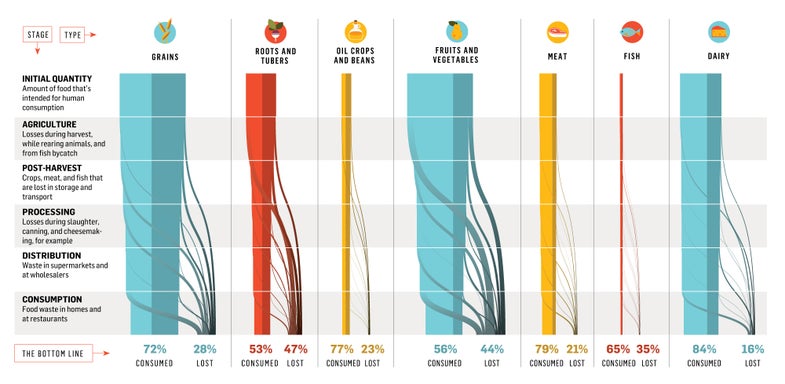How The World Wastes Food [Infographic]
From the farm to the dinner plate, here's where food gets lost.

Every year, the planet loses nearly a third of its food—a staggering 1.4 billion tons. That’s according to a 2011 United Nations study that assessed food networks in 152 countries. The researchers’ results reveal where in the food-supply chain farmers, engineers, and consumers might more effectively get comestibles into mouths.

Food waste, by production stage and food type

What to do about it
The planet may have to feed a global population of 10 billion people by 2050. With that milestone looming, organizations like the U.N., the Natural Resources Defense Council, and Food Tank are working on ways to make food systems more efficient.
Agriculture
Problem: Agricultural loss particularly plagues industrialized nations, where farmers often need to overproduce in order to guarantee a steady supply to grocery stores.
Solution: With better food labeling—for example, using a spoils-on date rather than a sell-by date—markets could keep their stock longer and ease demand on farmers.
Post-harvest
Problem: Food loss after harvest is a bigger problem in developing countries—where food infrastructure is often less modernized—than in industrialized ones.
Solution: Improving roads would enable unrefrigerated perishables to reach market faster, cutting down on spoilage. Investment in cold-storage facilities would also prevent losses.
Processing
Problem: Developing countries lose the most fruits and vegetables at the processing stage because it’s expensive to maintain facilities big enough to handle large seasonal influxes.
Solution: If the owners of processing facilities enter into contracts with individual farmers before they sow seeds, the timing and size of the harvest may be more predictable and manageable.
Distribution
Problem: If a supermarket rejects food once it leaves a processing plant—say, for having too many tomatoes already—the truck driver may not be able to find another buyer before the food spoils.
Solution: New mobile-phone apps, including one called Food Cowboy, help drivers locate nearby food banks that might take the shipment.
Consumption
Problem: At the last stage, consumers in industrialized countries waste five times as much food as those in developing ones. In the U.S., that means 35 million tons of food each year head to landfills and incinerators.
Solution: In the U.K., a public-awareness campaign cut household losses by 20 percent, by encouraging actions such as taking more frequent shopping trips to prevent groceries from spoiling.
_Data used to develop this graphic come from the U.N. Food and Agriculture Organization (FAO) report ©FAO 2011 “Global Losses and Food Waste,” part of the Save Food initiative. _
The Future of Food Preservation
To tackle food waste, the U.S. Department of Agriculture and partner Worrell Water Technologies developed a one-square-inch packet that extends the refrigerated life of fruits and vegetables by up to five weeks. Each permeable packet contains Curoxin vapor, a proprietary disinfectant that releases slowly inside a clamshell container and envelops fresh food in an antimicrobial cloud. The effect? Water loss and fungal growth are significantly arrested, which maintains produces’ firmness, color, and taste. Currently in trials, Curoxin should be available in 2015. —MATT JANCER